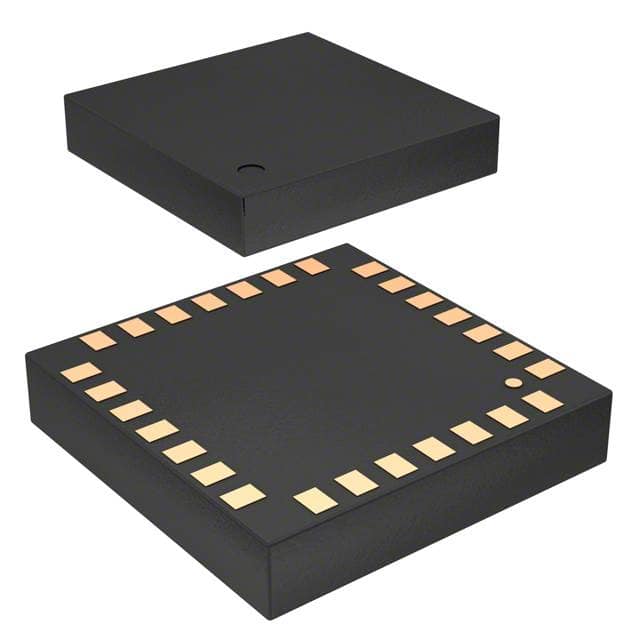LSM303DLMTR
Introduction
The LSM303DLMTR is a versatile and high-performance 3D accelerometer and 3D magnetometer module designed for various applications in the field of motion sensing and orientation detection. This entry provides an in-depth overview of the LSM303DLMTR, including its product category, basic information, specifications, pin configuration, functional features, advantages and disadvantages, working principles, application field plans, and alternative models.
Product Category
The LSM303DLMTR belongs to the category of motion sensing and orientation detection devices. It is widely used in applications that require accurate measurement of acceleration and magnetic fields.
Basic Information Overview
- Category: Motion Sensing and Orientation Detection
- Use: Accurate measurement of 3D acceleration and magnetic fields
- Characteristics: High performance, versatile, compact design
- Package: Small form factor package
- Essence: Integration of 3D accelerometer and 3D magnetometer
- Packaging/Quantity: Available in various packaging options with different quantities
Specifications
- Accelerometer:
- Measurement Range: ±2g/±4g/±8g/±16g
- Output Data Rate: 0.5 Hz to 1 kHz
- Interface: I2C/SPI
- Magnetometer:
- Magnetic Field Measurement Range: ±1.3 to ±8.1 gauss
- Output Data Rate: 0.625 Hz to 150 Hz
- Interface: I2C/SPI
Detailed Pin Configuration
The LSM303DLMTR module features a detailed pin configuration that includes power supply pins, communication interface pins, and sensor output pins. The pinout diagram provides a clear understanding of the connectivity requirements for integrating the module into a system.
Functional Features
- High Accuracy: Provides precise measurement of acceleration and magnetic fields
- Versatility: Suitable for a wide range of applications
- Low Power Consumption: Optimized for battery-powered devices
- Integrated FIFO: Allows storage of sensor data for efficient processing
Advantages and Disadvantages
Advantages
- Accurate and reliable measurement capabilities
- Compact and versatile design
- Low power consumption for extended battery life
- Integrated FIFO for efficient data handling
Disadvantages
- Limited measurement range compared to some competing models
- Higher cost compared to entry-level motion sensing modules
Working Principles
The LSM303DLMTR utilizes advanced MEMS (Micro-Electro-Mechanical Systems) technology to measure 3D acceleration and magnetic fields. The accelerometer and magnetometer sensors within the module detect changes in physical forces and magnetic fields, providing precise data for orientation and motion sensing applications.
Detailed Application Field Plans
The LSM303DLMTR finds extensive use in various application fields, including: - Consumer Electronics: Mobile devices, gaming controllers, and wearable gadgets - Automotive: Vehicle navigation systems, inertial measurement units - Industrial Automation: Robotics, motion tracking systems, and equipment monitoring - Aerospace: Attitude control systems, satellite orientation detection
Detailed and Complete Alternative Models
Several alternative models offer similar functionality to the LSM303DLMTR, including: - LSM303C: Enhanced version with higher measurement range and improved accuracy - HMC5883L: Standalone 3-axis magnetometer with I2C interface - ADXL345: 3-axis digital accelerometer with high resolution and low power consumption
In conclusion, the LSM303DLMTR is a highly capable motion sensing and orientation detection module with a wide range of applications across various industries. Its precise measurement capabilities, compact design, and versatile functionality make it a preferred choice for developers and engineers seeking reliable motion sensing solutions.
Word Count: 590
तकनीकी समाधानों में LSM303DLMTR के अनुप्रयोग से संबंधित 10 सामान्य प्रश्नों और उत्तरों की सूची बनाएं
What is the LSM303DLMTR?
- The LSM303DLMTR is a 3-axis accelerometer and 3-axis magnetometer module designed for motion-sensing applications.
What are the key features of the LSM303DLMTR?
- The LSM303DLMTR features high resolution, low power consumption, and a wide dynamic range, making it suitable for various technical solutions.
How can the LSM303DLMTR be used in navigation systems?
- The LSM303DLMTR's magnetometer can be utilized to provide heading information for navigation systems, while its accelerometer can detect changes in velocity and orientation.
In what types of devices can the LSM303DLMTR be integrated?
- The LSM303DLMTR can be integrated into smartphones, tablets, GPS devices, and wearable technology to enable motion and orientation sensing.
What are the communication interfaces supported by the LSM303DLMTR?
- The LSM303DLMTR supports both I2C and SPI communication interfaces, allowing for easy integration with microcontrollers and other devices.
How does the LSM303DLMTR contribute to motion tracking in sports and fitness applications?
- The LSM303DLMTR's accelerometer can accurately measure acceleration and movement, making it valuable for tracking physical activity and performance in sports and fitness devices.
Can the LSM303DLMTR be used in robotics applications?
- Yes, the LSM303DLMTR can provide crucial data for robot orientation, tilt compensation, and motion control in robotics applications.
What are the power requirements for the LSM303DLMTR?
- The LSM303DLMTR operates on a supply voltage ranging from 2.16V to 3.6V, with low power consumption, making it suitable for battery-powered devices.
How does the LSM303DLMTR support tilt-compensated compass applications?
- By combining data from its accelerometer and magnetometer, the LSM303DLMTR can provide accurate heading information even when tilted, enabling tilt-compensated compass functionality.
What are some common challenges when integrating the LSM303DLMTR into technical solutions?
- Challenges may include sensor calibration, magnetic interference, and optimizing sensor fusion algorithms for accurate motion sensing and orientation tracking.


